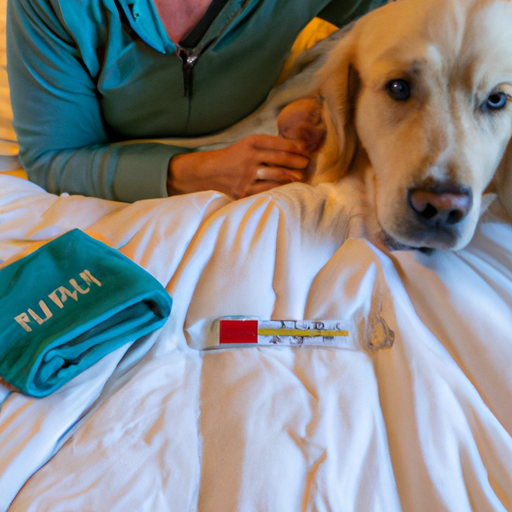As a loving pet parent, you play an instrumental role in your dog’s health and wellbeing. One of the most distressing situations can be when your dog has a fever. But, don’t worry! You’re not helpless in this situation. Here are some proven strategies you can employ to help bring down a dog’s fever.
1. Recognizing the Symptoms
Before you can effectively bring down a dog’s fever, you need to recognize the symptoms. Dogs can’t tell us when they’re feeling unwell, but their bodies show signs. These may include:
- Loss of appetite
- Lethargy or decreased activity
- Warm ears or hot body
- Shivering or shaking
- Coughing, vomiting, or other signs of distress
Always remember, if your pet shows any of these signs, it’s time to check their temperature.
2. Taking Your Dog’s Temperature
You might be wondering, “How do I take my dog’s temperature?” Well, it’s quite straightforward. Unlike humans, a dog’s temperature is most accurately checked rectally. Here’s a step-by-step guide:
- Use a digital thermometer specifically designed for dogs.
- Apply a pet-safe lubricant to the thermometer.
- Gently insert the thermometer about 1 inch into your dog’s rectum.
- Wait for the reading to stabilize before removing it.
The normal temperature range for dogs is between 101 and 102.5 degrees Fahrenheit. Anything above this range could indicate a fever.
3. At-Home Treatments
If your dog’s temperature is only slightly elevated, there are a few at-home treatments you could try before rushing to the vet.
- Keep your dog hydrated: Offer them plenty of fresh, cool water.
- Cool them down: Use cool (not cold) water to gently bring down the body temperature. Avoid immersing your dog in cold water as it could lead to shock.
- Rest: Allow your dog ample time to rest and recover.
Remember, these are temporary measures. If your dog’s fever persists, it’s time to call the vet.
4. When to Seek Veterinary Care
Sometimes, a fever is indicative of a more serious underlying condition. If your dog’s fever persists despite your at-home care, or if it is accompanied by other serious symptoms, you should seek veterinary care immediately.
| Situation | Action |
|---|---|
| Fever persisting more than 24 hours | Call the vet |
| Very high fever (over 104 degrees) | Seek immediate medical attention |
| Fever accompanied by other severe symptoms | Seek immediate medical attention |
5. Prevention is Better than Cure
Like with all health issues, prevention is better than cure. Ensure your dog is up-to-date with its vaccinations, receives regular check-ups, and maintains a healthy diet and exercise routine.
FAQs
Q: How can I tell if my dog has a fever without a thermometer?
A: While a thermometer is the most accurate method, you can check for warm ears, lethargy, loss of appetite, and shivering as potential indications of a fever.
Q: Can I use a human thermometer for my dog?
A: No, it’s recommended to use a thermometer specifically designed for dogs for accuracy and safety reasons.
Q: How long should I wait before taking my dog to the vet?
A: If the fever persists for more than 24 hours or is accompanied by other severe symptoms, seek veterinary care immediately.
Q: Can I give my dog human medication to bring down the fever?
A: Never give your dog medication without consulting a vet first. Some human medications can be harmful or even fatal to dogs.
Remember, you’re not just a pet owner, you’re a caregiver. Your dog depends on you to ensure their health and happiness. And with this guide, you’re well-equipped to handle one of the more common health issues your furry friend might face.



